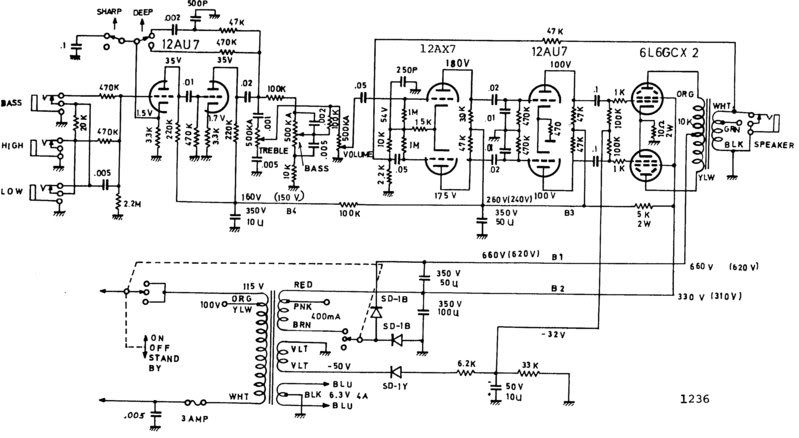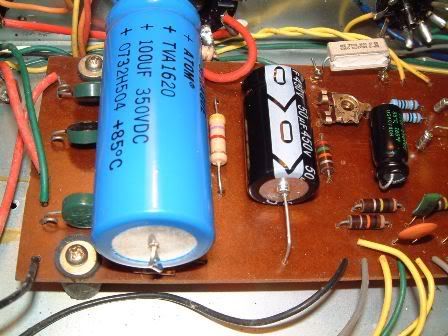I'm still working on a MIJ bass amp from the 60's.... yes I know it's been 2 weeks ( on and off though ). There is a 4ohm tap off the OT that is not being used. The wire is dangling inside the chassis. Currently the 8ohm tap is connected to the speaker jack and functional. I was wondering if disconnect the 8ohm tap and swap it with the 4ohm tap and run a 4ohm speaker would this cool my output tubes or vice-versa or no change?
Lafayette Bass Head (Univox 1236).
My main concern right now is, "slight" orange plating on the two 6L6's when tested. At idle (line voltage at 116V) the plates are reading 660V. I've been through the amp lifting and replacing components that are off spec by 20% or more. My line voltage on the bench is 123V and the schematic measurements were performed at 117V. I know this will bump the 6L6 plate voltages up about 40V+. I tried to adjust the bias at idle to make them cooler, but I've pegged the pot, no room left. Does biasing them hotter at idle make them run cooler when they are pushed (thought I read that someplace)?
I wouldn't usually be "as concerned" with an old amp made in Japan, figuring, it is, what it is and leave well enough alone but.... the amp has a very unique sound which is actually quite pleasant and worthy of using on smaller gigs.
I'm not savvy enough at this point to alter the circuitry enough to cool things down for modern day usage. Soooo.... I would most appreciate any knowledge given forward, from the guru's within this forum. Many thanks, once again.
Regards,
Gary

Lafayette Bass Head (Univox 1236).
My main concern right now is, "slight" orange plating on the two 6L6's when tested. At idle (line voltage at 116V) the plates are reading 660V. I've been through the amp lifting and replacing components that are off spec by 20% or more. My line voltage on the bench is 123V and the schematic measurements were performed at 117V. I know this will bump the 6L6 plate voltages up about 40V+. I tried to adjust the bias at idle to make them cooler, but I've pegged the pot, no room left. Does biasing them hotter at idle make them run cooler when they are pushed (thought I read that someplace)?
I wouldn't usually be "as concerned" with an old amp made in Japan, figuring, it is, what it is and leave well enough alone but.... the amp has a very unique sound which is actually quite pleasant and worthy of using on smaller gigs.
I'm not savvy enough at this point to alter the circuitry enough to cool things down for modern day usage. Soooo.... I would most appreciate any knowledge given forward, from the guru's within this forum. Many thanks, once again.
Regards,
Gary



Comment